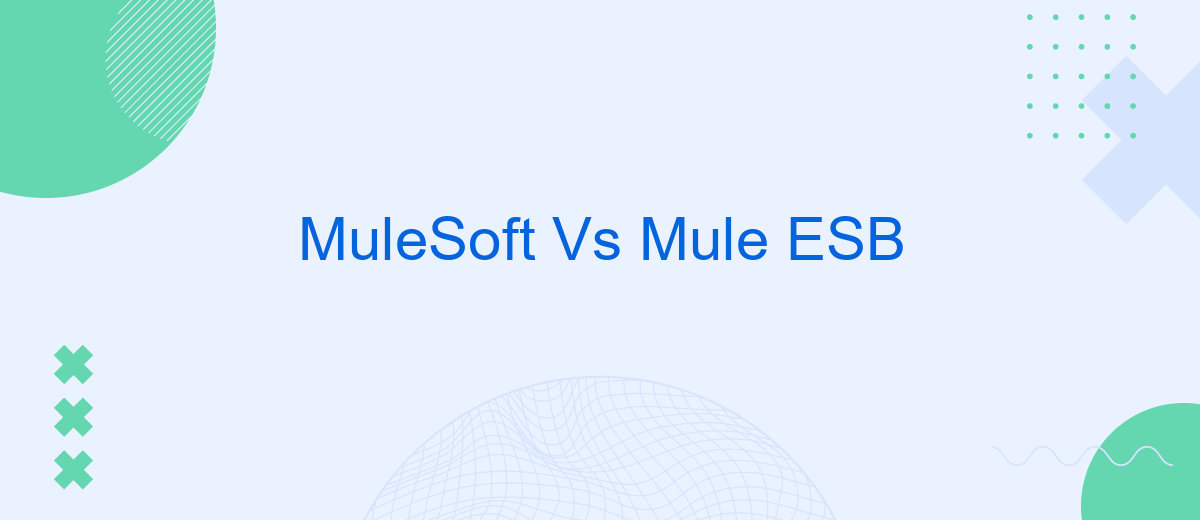In the rapidly evolving landscape of enterprise integration, choosing the right tools is crucial for seamless connectivity and efficient data flow. This article delves into the distinctions between MuleSoft and Mule ESB, two prominent solutions in the integration space. By understanding their unique features and capabilities, businesses can make informed decisions to optimize their integration strategies and drive digital transformation.
Introduction
In the rapidly evolving landscape of enterprise integration, choosing the right tools and platforms is crucial for seamless data flow and operational efficiency. MuleSoft and Mule ESB have emerged as prominent solutions, each offering unique capabilities to address integration challenges. Understanding the differences and benefits of these platforms can help organizations make informed decisions tailored to their specific needs.
- MuleSoft: A comprehensive integration platform that provides tools for connecting applications, data, and devices across on-premises and cloud environments.
- Mule ESB: A robust enterprise service bus (ESB) designed to enable communication and data exchange between different applications and systems.
While both MuleSoft and Mule ESB offer powerful integration solutions, it's essential to evaluate their features and functionalities in the context of your organization's goals. Additionally, tools like SaveMyLeads can further enhance your integration strategy by offering automated lead data transfer between various platforms, ensuring that your sales and marketing teams have access to up-to-date information without manual intervention.
Comparison of Features

MuleSoft and Mule ESB are both powerful tools in the integration landscape, but they serve different purposes and offer distinct features. MuleSoft, as a comprehensive integration platform, provides a wide range of tools and services to connect applications, data, and devices. It offers API management, design, and analytics capabilities, making it a robust solution for enterprises looking to streamline their integration processes. Mule ESB, on the other hand, is a lightweight enterprise service bus that focuses on enabling seamless communication between different applications and services. It is part of the MuleSoft suite but can be used independently for simpler integration tasks.
When it comes to setting up integrations, MuleSoft's Anypoint Platform stands out with its user-friendly interface and extensive support for various protocols and data formats. It also provides pre-built connectors and templates to accelerate integration projects. SaveMyLeads can be a valuable addition here, offering automated integration solutions that save time and reduce manual effort. Mule ESB, while not as feature-rich as MuleSoft, excels in scenarios where lightweight and efficient message routing and transformation are required. It supports a wide range of transport protocols and message formats, making it a versatile choice for specific integration needs.
Use Cases and Benefits

MuleSoft and Mule ESB serve distinct purposes in the realm of integration, each providing unique benefits tailored to specific use cases. MuleSoft's Anypoint Platform is designed for comprehensive API management, offering tools for designing, building, and managing APIs at scale. Mule ESB, on the other hand, focuses on seamless integration across various systems, acting as a robust enterprise service bus.
- API Management: MuleSoft excels in creating and managing APIs, making it ideal for organizations looking to expose services and data to external partners.
- System Integration: Mule ESB is perfect for integrating disparate systems within an organization, ensuring smooth data flow and process automation.
- Cloud Connectivity: Both MuleSoft and Mule ESB offer strong cloud integration capabilities, essential for modern hybrid architectures.
- Automation: Services like SaveMyLeads can be integrated to automate lead management processes, enhancing the efficiency of marketing and sales operations.
By leveraging these platforms, businesses can achieve greater agility and scalability. MuleSoft's API-centric approach is ideal for digital transformation initiatives, while Mule ESB's integration capabilities ensure cohesive operations across legacy and modern systems. Together, they provide a robust framework for tackling a wide range of integration challenges.
Pricing and Licensing

When comparing MuleSoft and Mule ESB, pricing and licensing play a crucial role in decision-making. MuleSoft offers a more comprehensive suite of tools and services, which is reflected in its pricing model. MuleSoft's Anypoint Platform is available through subscription-based licensing, which includes access to its cloud-based services and support.
On the other hand, Mule ESB, being an open-source solution, offers more flexibility in terms of initial costs. Users can download and use Mule ESB for free, but enterprise features and support come at an additional cost. This makes Mule ESB a cost-effective solution for smaller projects or organizations with limited budgets.
- MuleSoft: Subscription-based, includes cloud services and support
- Mule ESB: Open-source, free to use with optional enterprise features
It's essential to evaluate your organization's specific needs and budget constraints when choosing between MuleSoft and Mule ESB. For businesses looking to streamline their integration processes, tools like SaveMyLeads can complement either platform by automating data flows and reducing manual workload, ultimately enhancing overall efficiency.
Conclusion
In conclusion, both MuleSoft and Mule ESB offer robust solutions for integration needs, but they cater to slightly different audiences and requirements. MuleSoft provides a comprehensive integration platform that includes API management, design, and analytics, making it suitable for enterprises seeking an all-encompassing solution. On the other hand, Mule ESB is a more focused tool that excels in connecting different systems and applications with its lightweight and scalable architecture.
For businesses looking for additional, user-friendly integration solutions, services like SaveMyLeads can be invaluable. SaveMyLeads simplifies the process of connecting various applications and automating workflows without requiring extensive technical knowledge. By leveraging such services alongside MuleSoft or Mule ESB, organizations can achieve a more seamless and efficient integration process, ultimately driving better business outcomes.
FAQ
What is MuleSoft?
What is Mule ESB?
How does MuleSoft differ from Mule ESB?
Can MuleSoft be used for automating workflows?
Is there an alternative to MuleSoft for simpler integrations?
Are you using Facebook Lead Ads? Then you will surely appreciate our service. The SaveMyLeads online connector is a simple and affordable tool that anyone can use to set up integrations for Facebook. Please note that you do not need to code or learn special technologies. Just register on our website and create the necessary integration through the web interface. Connect your advertising account with various services and applications. Integrations are configured in just 5-10 minutes, and in the long run they will save you an impressive amount of time.
